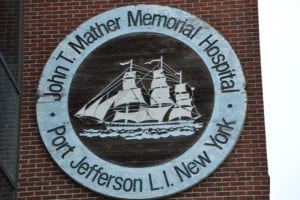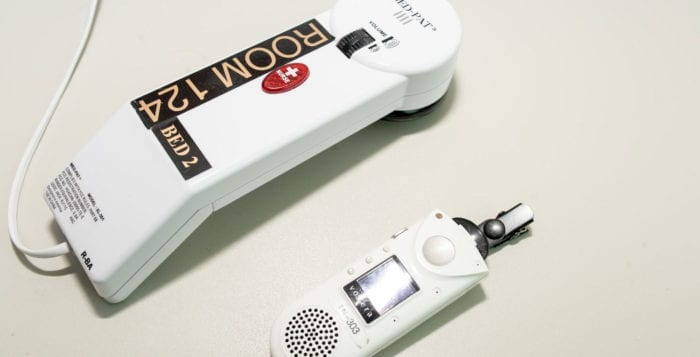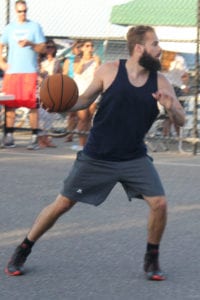Brookhaven Town will hold a blood drive Tuesday, Aug. 23, from 8:30 a.m. to 4 p.m. in the Town Hall auditorium in the hopes of alleviating an emergency blood shortage. Brookhaven Town Hall is located at 1 Independence Hill in Farmingville. Those seeking more information are advised to call 631-451-9100.
Repair program in Smithtown helps out seniors

By Joseph Wolkin
Smithtown’s Residential Repair Program is out in full force this summer. With no cost of labor, participants must only provide the materials being used.
Assisting seniors 60 years old and over, the repair program looks to make an impact on the local community, giving back to those who don’t want to risk any injury while making a repair.
Laura Greif, program director, said residents are responding well to the service.
“I think people love this program,” she said in a phone interview. “It’s nice to know the community can assist seniors in their homes. This program is for renters also. You can have someone come do a repair for you instead of having the charge of paying for a plumber or electrician. But it’s only minor repairs.”
The repair program has five part-time workers, with hopes of hiring a sixth one shortly, Greif said. Serving anywhere from 10 to 15 people a day, the program director believes the organization is making a great impact on the local community.
Services range from changing light bulbs and smoke detectors, to repairing faucets and even cleaning first floor gutters.
Funding for the Residential Repair Program is provided by the New York State Office for the Aging, Suffolk County Office for the Aging and Town of Smithtown.
“The program is a state, county and town-funded program,” Greif said. “The idea of this program is to keep our seniors safe in their homes. We provide small repair services for them, like light bulbs changed, smoke detectors, weatherization, their faucets are leaking or they need them changed, and all they do is pay for the materials.”
Steve Ingram, an employee who works for the program, recognizes the impact they make within the Smithtown community.
“We go into the homes and work on minor plumbing, replace a faucet, the insides of a toilet, minor electrical work, replace light switches and outlets, change light bulbs that the seniors can’t reach, minor carpentry and just safety-related items,” Ingram said in a phone interview. “We do minor repairs that don’t require a licensed electrician or plumber to do the work.
But Ingram said the safety jobs are the most crucial service they provide to seniors.
“The most important things we do are the safety-related items, like changing carbon monoxide detectors and smoke detectors, because it’s just important we get right on top of those,” he said. “When they call those in, we’re usually on them by the next day.”
The employees are maintenance mechanics, but are not licensed plumbers or electricians, Greif said.
The positive feedback ranks among the most enjoyable parts of helping out the seniors of Smithtown, according to the workers involved.
“It is a great feeling to help the seniors,” Ingram said. “When I first took the job, I anticipated that I would get some type of satisfaction in helping them. The feedback that we get from them is what helps the program as well. It’s great for all of us.”
For people who want a service performed at their house, call the organization’s office at 631-360-7616. All patrons must complete a work order that states what services they need done, along with answering a few additional questions for the program’s reporting purposes.
Stony Brook Medicine and Mount Sinai Health System team up, expanding scientific possibilities

By Talia Amorosano
Two major medical institutions have agreed to team up, and the partnership could lead to big scientific breakthroughs.
In order to create more academic research opportunities and streamline and expand clinical care initiatives, Stony Brook Medicine and Mount Sinai Health System, in New York City, have entered into a comprehensive affiliation agreement. The change will promote inter-institution collaboration encompassing all five of Stony Brook’s Health Science schools, Stony Brook University Hospital, all 25 academic departments of the Stony Brook University School of Medicine, Mount Sinai Health System facilities and Medical School, and the Icahn School of Medicine at Mount Sinai inclusive of seven hospitals and an expanding ambulatory network.
Facilitators of the partnership believe that the expansion of clinical trials and research opportunities for both institutions will prompt research and studies that could lead to major discoveries, especially in the treatment and understanding of disease.
Dr. Kenneth Kaushansky, senior vice president for Health Sciences at Stony Brook University, noted that the alliance will make use of the strengths of each individual institution.
“What we both get out of the affiliation is enhanced possibilities for science and education,” he said. “Multiple groups of investigators [with members from each institution] work together and look at things in slightly different ways.”
In a press release, he noted Mount Sinai’s Icahn School of Medicine for its strong biomedical, clinical research and health policy expertise and Stony Brook University for its advanced mathematics, high-performance computing, and physical and chemical science departments to illustrate the point that these institutions can accomplish collaboratively more than each can do alone.
“In the long term were gonna roll out more and more in the way of clinical interactions,” said Kaushansky, who mentioned Stony Brook’s recent recruitment of two new cardiac surgeons from Mount Sinai. “We don’t do heart transplants, but Mount Sinai does.”
He emphasized the new potential for patients to easily seek services from either hospital. In fact, joint research programs ranging from fields of biomedical engineering and computer science to medicinal chemistry science, neurology, psychiatry, therapeutics and more are currently in the works.
“Stony Brook Medicine and the Icahn School of Medicine at Mount Sinai are two powerhouses of research that when partnered will definitely yield more than just the sum of their parts.”
—Lina Obeid
In terms of education, University students will now be afforded the unique opportunity to take classes offered on either or both campuses, and participate in a variety of summer programs geared toward students of all ages. The two schools plan to facilitate joint graduate and medical educational programs in a wider range of subjects than ever before, and have agreed to invest a collaborative $500,000 for the development of academically challenging pilot programs to be supervised by a joint committee.
“The joint pilots in research have immense promise to advance health at the most exciting time in the biomedical sciences, including advanced computational, bioinformatic and engineering approaches,” said Lina Obeid, MD, dean for research and vice dean for scientific affairs at Stony Brook University School of Medicine. “Stony Brook Medicine and the Icahn School of Medicine at Mount Sinai are two powerhouses of research that when partnered will definitely yield more than just the sum of their parts.”
Other leaders of each institution have already expressed similar enthusiasm about the affiliation, which was effective immediately upon signing, and many have verbalized hopes that groundbreaking research will take place as a result of this strategic partnership.
Dr. Kenneth L. Davis, president and chief executive officer of the Mount Sinai Health System, said, “Together [Mount Sinai and Stony Brook] will use our outstanding resources to create changes in medicine.”
“Each institution has so much to offer,” said Stony Brook University President Samuel L. Stanley Jr., “this is an opportunity that will prove to be beneficial to all — now and in the future — as we explore and grow this incredible collaboration.”
Looking toward the future, Kaushansky said that Stony Brook has more affiliation agreements in the works, contingent upon state approval.
“We are working very hard with our friends in the state of New York to get approval for affiliation with Southampton Hospital and Eastern Long Island Hospital in Greenport,” he said.
Also pending is a potential partnership with John T. Mather Memorial Hospital in Port Jefferson. “In April, Mather Hospital asked a number of healthcare systems — us included — whether they were interested in affiliating with Mather Hospital, and we said yes,” Kaushansky said. “We made a proposal to the Mather hospital board … and they were supposed to decide [with whom they wish to affiliate] back in June.”
About a year ago, Kaushansky said he wondered aloud how it is that the insistution could make a bigger impact on clinical medicine, education and research. He now expresses confidence that Stony Brook’s affiliation with large city medical center, Mount Sinai, and future mutually-beneficial partnerships with Long Island hospitals and medical centers, is the most surefire way to achieve such an impact.
New residency programs underway at Mather
By Kevin Redding
Under the sponsorship of Stony Brook University Hospital, John T. Mather Memorial Hospital in Port Jefferson has recently launched two new medical residency programs: one focused in psychiatry and the other in diagnostic radiology.
These programs, which officially joined existing residency programs, internal medicine and transitional year, on July 1, will serve to solidify Mather as an ever-expanding hub of academic training for its medical school graduates, and offer high-quality health care to its Suffolk County patients.
Both are four-year programs, offered to five residents per year in psychiatry and three per year in diagnostic radiology, that will give residents hands-on access to technology, clinics and patients relating to the specific field.
Those in the psychiatry program will benefit from Mather’s two inpatient psychiatry units for adults and adolescents and various clinics, including one for eating disorders and chemical dependency. According to Dr. Noam Fast, the program’s director, the residents will undergo an unusually didactic schedule, rotating between classroom lectures from the clinical faculty and working with patients directly — which will allow them to hone their craft.
“We’re training the next generation… and hopefully they decide to stay in our local community and actually treat our community members.” — Jared Dunkin
“Mather actually had a lot of psychiatry services and that is what you need to be able to train residents the right way,” Fast said. “You need all of these services, and when you have all these opportunities, it becomes the basis to teach. The patients benefit, the staff benefits and the hospital and community at large do, as well.”
Radiology residents will learn to understand and operate the inordinate amount of technology the field consists of. The residents must know how to read a wide spectrum of imaging, including X-ray, radiographs, MRI scans, CT scans, ultrasound and mammography.
Dr. Jared Dunkin, director of the radiology program, said that even though it will be a steep learning curve — using the computers and dictation systems — it’s something that students will be acclimated to in just a few months. Residents will also be learning the tools of the trade that can potentially prevent life-ending ailments within the body.
“For us, imaging is giving insight into what is going on in the body without having to cut them open,” Dunkin said. “It gives us a window into the organs just to come up with a diagnosis. There’s a lot of screening programs through radiology. They’re developing chest-screening programs, for instance, to identify people at risk for lung cancer. We try to identify these cancers early, so that way the doctors can treat them earlier.”
In order to find their residents, Fast and Dunkin used what’s called a “match,” an elaborate computer program used as an application process in medical circles. Medical students in their fourth year send in their resumes, transcripts, school test scores and recommendation letters. Fast and Dunkin then sift through hundreds of potential residents and narrow the candidates down to a select few for interviewing and ranking.

Then, on “match day,” the computer takes the list and pairs the students with a certain program. Usually, Fast and Dunkin have months to do this, but due to a late accreditation, they only had a little more than a week this time around. Even with limited time, the directors said they’re happy with the final selections.
The goal was to find those who are bright, dedicated, interested in learning and could potentially have a long-lasting career within Suffolk County.
“The residency programs are a lifeline for the community,” Fast said. “You have a chance to train residents in your own program, and then the expectation is that a proportion of the residents would be interested in this community, and we do hope that we can attract some of these doctors and recruit them, as well.” Dr. Joan Faro, chief medical officer at Mather, said last year that the partnership between Stony Brook and Mather, in forming a new graduate medical education program, would only strengthen the level of care the community hospital provides by reinforcing the facility’s standards. The new programs should take those standards to new heights.
Dunkin has an eye on the future of the hospital when speaking about the new programs.
“We’re training the next generation,” he said. “A lot of residency programs look to their former residents to fill the ranks when needed. So we’re training the next generation, and hopefully they decide to stay in our local community and actually treat our community members.”
Brookhaven Town extends pool, beach hours
To help residents keep cool during the extreme heat wave, Brookhaven Town will extend hours at municipal pools and beaches on Friday, Aug. 12 and Saturday, Aug. 13.
The town’s Centereach and Holtsville pools will be open from 11 a.m. to 7 p.m. on Friday and Saturday, and West Meadow Beach in Stony Brook, Cedar Beach in Mount Sinai and Corey Beach in Blue Point will be open from 11 a.m. to 7 p.m. Normal operating hours at all facilities will resume on Sunday, Aug. 14.
For more information, call 451-TOWN or visit www.Brookhaven.org.
Huntington Hospital’s new technology gets nurses to patients quicker

Huntington Hospital is breaking new ground in patient care with the Nightingale phone, a communication system that helps put patients in connection with nurses quicker than ever before.
The hospital has been piloting the new phone in the oncology wing of the hospital since 2015, and has seen a significant improvement in patient care and a decrease in wait time from when a patient calls for a nurse and when the nurse arrives to give treatment.
Patients are raving about the new invention.
Mary Ellen Cantone, a patient at the hospital, said the response to her call was immediate.
“I hit the button and someone was talking to me instantly,” she said in a statement. She said once at 2 a.m. she called for her nurse for ice chips, and the nurse came in right away with them.
“It has really improved nursing care and nursing work.” — Shanell Blanchard
“It’s a wonderful thing to use, it saves them time and they just know everything,” Cantone said. “They’re the best nurses here, and God picks the nurses for this floor, the oncology floor.”
The phone, created by Marie Roggenkamp, nurse manager at Huntington Hospital, has a red nurse button on the back that, when pressed directly, calls the device the patient’s nurse is wearing so that the patient can talk to his or her nurse immediately without the typical wait time.
Stephen Smith, manager of site communications at the hospital, worked with Roggenkamp to create the phone, which is an improvement from the call bell system hospitals use now.
“The call bell system requires a nurse to be close enough to hear the call bell or see the light go off outside the patient’s room, and may take longer to get a response,” he said in a statement. “This allows the patient to connect with the nurse no matter where they are on the unit.”
Roggenkamp said she saw success in patient satisfaction scores in the oncology wing after the Nightingale was implemented back in July 2015. She said call bell responses could take anywhere from seven to eight minutes, but with the Nightingale, a nurse could be in the room with medication within two minutes.
One of the most important features of the Nightingale phone is the call forward feature.
A concern with having nurses wear a device that can immediately connect them with a patient is the opportunity for increased error if the nurse is already performing a procedure when a call comes from a new patient.
“In the event a nurse is hanging chemotherapy [drugs from an IV], she can have a call [from the Nightingale] forwarded to a nursing assistant,” Roggenkamp said. If the assistant is also busy, the call will then go to the nurse manager, and then the call desk.
This pilot program is also cost effective; to add a speed-dial button to the hospital phones only costs an extra 50 cents.
The nurse manager said Huntington Hospital hopes to have the Nightingale phone installed in every unit by the end of 2016.
Nurses at the hospital like the new system as much as management.
“It has really improved nursing care and nursing work,” nurse Shanell Blanchard said. “I know what they need before going in there. Before, a call bell could be going off in another room, but it might take me five minutes to answer it. I need to finish with the patient I am with, wash my hands, ask what they need and then go get it.”
Blanchard said patients have also enjoyed the fact they have more control in their care.
“It’s a great feeling of independence,” she said. “To know if I press that button I can get to my nurse directly.”
Roll up both sleeves — understanding and controlling blood pressure
This week, I’d like to discuss some of the nuances of hypertension, or high blood pressure, a contributing risk factor for heart disease. Hypertension affects approximately 33 percent of Americans, according to the latest statistics from the Centers for Disease Control and Prevention, and only 52 percent of these have it controlled (1). What could we possibly learn about blood pressure that we have not heard already? New information is always coming out about this common disease. Studies are teaching us about diagnostic techniques and timing, as well as consequences of hypertension and its treatment. Let’s look at the evidence.
Technique
When you go to the doctor’s office, they usually take your blood pressure first. But do they take readings in both arms and, if so, have you wondered why? I take blood pressure readings in both arms, and when one of my longtime patients asked me why, I joked that I need to practice. In truth, it’s because there may be significant benefit from taking readings in both arms.
An analysis of the Framingham Heart Study and Offspring Study showed that when the blood pressure was taken in both arms, when there was a difference of more than 10 mm Hg in the systolic (top number) blood pressure, then there may be an increased risk for the development of cardiovascular disease — stroke and heart disease (2).
This is a simple technique that may give an indication of who is at greater cardiovascular disease risk. In fact, when this interarm blood pressure comparison showed a 10 mm Hg difference, it allowed the researchers to identify an almost 40 percent increased risk of having a cardiac event, such as a stroke or a heart attack, with minimal extra effort expended.
So, the next time you go to the doctor’s office, you might want to ask if they would take your blood pressure in both arms to give you and your doctor a potential preliminary indication of increased cardiovascular disease risk.
Timing
When do we get our blood pressure taken? For most of us it is usually at the doctor’s office in the middle of the day. This may not be the most effective reading. Nighttime blood pressure readings may be the most accurate, according to one study (3). This was a meta-analysis (a group of nine observational studies) involving over 13,000 patients. Neither the clinical nor daytime readings correlated significantly with cardiovascular events when multiple confounding variables were taken into account, while every 10 mm Hg increase at night had a more significant predictive value.
Twenty-four ambulatory blood pressures readings were taken with these patients, which means these were standardized readings. Does this mean that nighttime readings are more important? Not necessarily, but it is an interesting finding. With my patients, if blood pressure is high in my office, I suggest that patients take their blood pressure at home, both in the morning and at night, and send me readings on a weekly basis. However, at least one of the readings should be taken before antihypertensive medications are taken, since these will alter the readings.
Salt impact
There has always been a debate about whether salt really plays a role in high blood pressure and heart disease. The latest installment in this argument is a compelling British study called the Health Survey from England. It implicates sodium as one potential factor exacerbating the risk for high blood pressure and, ultimately, cardiovascular disease (4). The results show that when salt intake was reduced by an average of 15 percent, there was a significant blood pressure reduction and that this reduction may be at least partially responsible for a 40 percent reduction in stroke mortality and a 42 percent reduction in heart disease mortality.
The graphs of sodium reduction mimicked the line graphs for the reductions in deaths from stroke and heart disease. One potential study weakness was that physical activity was not taken into account. However, a strength of this study was that it measured salt intake through 24-hour urine tests. Most of our dietary salt comes from processed foods that we least suspect, such as breads, pastas and cheeses.
Age-related macular degeneration
When we think of blood pressure-lowering medications, we don’t usually consider age-related macular degeneration as a potential side effect. However, in the Beaver Dam Eye Study, those patients who were taking blood pressure medications were at a significant 72 percent increased overall risk of developing early-stage AMD (5). It did not matter which class of blood pressure-lowering drug the patient was using, all had similar effects: calcium channel blockers, beta blockers, diuretics, and angiotensin receptor blockers.
However, the researchers indicated that they could not determine whether the blood pressure or the blood pressure medication was the potential contributing factor. In addition, another study actually suggests the opposite — that blood pressure medications may reduce the risk of AMD (6). However, this was a retrospective (backward-looking) study, and it has yet to be published.
This is a controversial topic. If you are on blood pressure medications and are more than 65 years old, I would recommend that you get yearly eye exams by your ophthalmologist.
Fall risk
As we age, falling risk seems to increase. One study shows that blood pressure medications significantly increase fall risk in the elderly (7). Overall, 9 percent of these patients on blood pressure medications were seriously injured when they fell. Those who were considered moderate users of these medications had a 40 percent increased risk of fall. But, interestingly, those who were consider high-intensity users had a slightly less robust risk of fall (28 percent) than the moderate users. The researchers used the Medicare database with 5,000 participants as their data source. The average age of the participants in the study was 80.
Does this mean that we should discontinue blood pressure medications in this population? Not necessarily. This should be assessed at an individual level between the patient and the doctor. Also, one weakness of this study was that there was no dose-response curve. In other words, as the dosage increased with high blood pressure medications, one would expect a greater fall risk. However, the opposite was true.
In conclusion, we have some simple, easy-to-implement, takeaways. First, consider monitoring blood pressure in both arms, since a difference can mean an increased risk of cardiovascular events. Reduce your salt intake; it appears that many people may be sensitive to salt, as shown by the British study. If you do take blood pressure medications and are at least 65 years old, take steps to reduce your risk of falling and have annual ophthalmic exams to check for AMD.
References: (1) CDC.gov/blood pressure. (2) Am J Med. 2014 Mar;127(3):209-215. (3) J Am Soc Hypertens 2014;8:e59. (4) BMJ Open 2014;4:e004549. (5) Ophthalmology online April 30, 2014. (6) ARVO 2013 Annual Meeting: presentation. (7) JAMA Intern Med. 2014;174(4):588-595.
Dr. Dunaief is a speaker, author and local lifestyle medicine physician focusing on the integration of medicine, nutrition, fitness and stress management. For further information, visit www.medicalcompassmd.com or consult your personal physician.
Miller Place family stands strong against drugs

By Kevin Redding
In the face of tragedy, there’s one of two directions you can go. You can react to it optimistically and see what good can come out of it, or you can let it control your life and pin you down. The Engel family, of Miller Place, refuses to be pinned down. In fact, they’re well on their way to making great strides in their community.
Tuesday marked the 2nd Annual Jake Engel Hoops for Hope fundraiser at Cedar Beach in Mount Sinai — a day of competitive basketball all in the memory of a wonderful student and athlete taken too soon.
After Engel’s passing from a heroin overdose last year, his younger brother Patrick acted quickly and — with the help of his family and friends — put the event together in just a few short days, raising more than $5,000 for Hope House Ministries, a center in Port Jefferson where Jake Engel lived for two years, which provides care to young people and families in crisis.

Knowing that they wanted to expand on what they accomplished last year, the Engel family — Bob, Karen, Geoff and Patrick — set out to raise money this time around not just for Hope House but for the development of a scholarship at Miller Place High School and nonprofit organization in their son and brother’s name.
“We wanted something that was actually about Jake — In his name, dedicated to him,” said Patrick Engel. “Hope House is wonderful and we love Hope House … but we want something separate from it to remember him more personally.”
Both programs-to-be are in the beginning stages, but even though the qualifiers for the scholarship are not set in stone quite yet, the core mission certainly is. The Engel family is determined to raise awareness about the all-too prevalent drug problem sweeping Long Island and wants to do everything they can to prevent any drug-related tragedies in the future.
“The idea behind the scholarship and nonprofit is to be educating kids in the school district about these types of things,” said Geoff Engel, Jake Engel’s brother. “So we thought that setting up a scholarship would be a good way to promote that. The nonprofit could also hopefully provide housing for kids who are not able to get into rehabs or other types of organizations.”
Bob Engel, Jake Engel’s father, is especially determined to zero in on youth.
“Kids have to be educated,” he said. “It’s out of control out there, and I really want to gear everything toward the younger kids. They gotta get it in their head. Start in 5th grade with lectures every month and a half. The drug dealers aren’t going away no matter what, so at this point it’s about the education of younger people. The community needs to know what’s going on. [Hoops for Hope] is a good thing. This money is going toward educating these kids.”
Karen Engel, Jake Engel’s mother, said the family is still finalizing the details of the scholarship but are thinking of awarding it to someone who has overcome adversity and who does well academically because “that was Jake.”
“He was a very good student and loved his academics, and school and learning,” she said. “So that’s kind of the direction we’re going in.”
She hopes that both the scholarship and organization will encourage more people to become actively involved.

If this year’s fundraiser was any indication, people are ready to turn their attention to this issue.
Geoff Engel said that while last year’s fundraiser was very spontaneous and slapped together quickly, this year’s was a lot more organized.
“We’ve done a much better job promoting the event,” said Geoff Engel, who recently appeared on 103.9 WRCN-FM to spread the word. “We’re really hoping to raise at least twice as much as last year. It’s a much bigger event.”
For starters, last year’s basketball tournament had about 15 teams of 3, and this year boasted 26, with a donation of $15 per team to participate. But the event’s biggest source of income came with the addition of event T-shirts at $10 each, provided by the company Inkterprise, and a raffle.
Some of the donated items included a 32-inch flat-screen TV, a 3-month membership to Planet Fitness and a car care basket with three auto inspections provided by Rapid Inc. The Town of Brookhaven also supported the fundraiser and donated four box seat tickets to the Yankee game this upcoming Saturday, a $100 Modell’s gift card and the basketball court at Cedar Beach, waiving the standard $400 fee to rent it.
“I live right next door in Rocky Point and so many communities on the North Shore have been devastated with overdoses,” said Brookhaven Councilwoman Jane Bonner (C-Rocky Point). “We decided to take a stronger role this year … we all collectively decided to roll up our sleeves and become more involved and bring more awareness.”
For the Engel family, whose constant strength and selflessness has perpetuated this call for awareness, the focus is making sure the scholarship and nonprofit organizations get off the ground. If things go as planned, that should be the case by graduation next year.
“We’re trying to do anything we can just so people will talk about it,” Karen Engel said. “We want people to be aware that they can reach out to get help.”
This version corrects the spelling of the company name Inkterprise.
Eye on Medicine: The Pursuit of Health Care Excellence
By L. Reuven Pasternak, MD
How can you be sure you’ll get safe, quality care when you go to a hospital? You can consult any of the numerous rating systems created by the government, insurance companies, medical associations, registries, health care report cards, national magazines and patient evaluation websites. However, because there are no common guidelines for rating attributes like hospital quality or safety, it’s difficult to make apples-to-apples comparisons. The same hospital can be rated at the top by one agency and at the bottom by another.
When you’re searching for information, rely only on results from reputable, unbiased sources. And make sure the information is up-to-date. A ranking or a report card based on data that’s more than a year old may no longer be accurate.
With no single source of reliable, relatable information to evaluate health care providers, how can you uncover the facts you need?
Ask your primary care physician for a referral. Your doctor is very familiar with the quality of care that hospitals and specialists in your area provide. Talk to family and friends who’ve had firsthand experience. Ask nurses and doctors if they would send their relatives to that hospital or specialist.
Hospital and state health department websites provide statistics about procedures, results, specialists and facility certifications. Some hospitals also post information about the specialists who work there. If you’re having heart or orthopedic surgery, for example, get specifics about those procedures. Find out how often the surgeon and surgical team have done the procedure and what the nurse-to-patient ratio is, as well as the rate of readmissions and infections, in addition to other indicators of safety and quality.
And, find out what the hospital is doing to improve. Hospitals should always be looking to raise the bar, to pursue excellence. With our Patient Safety First program and other quality and safety initiatives, Stony Brook University Hospital has instituted rigorous systems to identify and prevent potential issues rather than react to them.
To enhance the patient experience, we have made and continue to make many improvements. For example, we’ve created “quiet times,” which involve shutting lights during specified times during the day, and we will also be offering noise reduction aids in the near future. To make the rooms more comfortable, we’re improving furnishings and creating a clutter-free environment. And, beyond the walls of our hospital, we’re taking steps to coordinate care among more than 500 countywide organizations to support health care providers and patients in achieving individual health goals.
Finally, don’t wait until an emergency happens to learn about health care facilities in your area. There is a lot of useful information available to help people make good choices, but it’s best accessed before you need it. At Stony Brook University Hospital, we want to answer all your questions — simply call our Department of Patient Advocacy at 631-444-2880 or visit www.stonybrookmedicine.edu.
Our goal is to exceed your expectations every time you turn to Stony Brook for your care — by delivering high quality, safe and compassionate care that supports your well-being every step of the way.
L. Reuven Pasternak, MD, is the CEO at Stony Brook University Hospital and vice president for health systems at Stony Brook Medicine
Let the Dietary Fat Wars Begin
Dietary fat is one of the most controversial and complicated topics in medicine. Experts have debated this topic for years, ever since we were told that a low-fat diet was important. There are enumerable questions, such as: Is a high-fat diet good for you? What about low-fat diets? If this is not enough, what type of fats should we be consuming?
There are multiple types of fats and multiple fat sources. For instance, there are saturated fats and unsaturated fats, which include monounsaturated and polyunsaturated. There are also trans fats, which are man-made. However, there are several things that we can agree on, like we need fat since the brain is made of at least 60 percent fat (1), and trans fats are downright dangerous. Trans fats are the Frankenstein of fats; anything created in a lab when it comes to fats is not a good thing.
How have we evolved in the fat wars? Originally we were told that a low-fat diet was beneficial for heart disease and weight loss (2). This started in the 1940s but gained traction in the 1960s. By the 1980s, everyone from physicians to the government to food manufacturers was exclaiming about a low-fat diet’s benefits for overall health. But did they go too far trying to make one size fit all? The answer is a resounding YES!!
There are only three macronutrients: fats, carbohydrates and protein. Declaring that one of the three needed to be reduced for everyone did not have the results we wanted or expected. Americans were getting fatter, not thinner, heart disease was not becoming rare, and we were not becoming healthier.
Some fats more equal than others
The biggest debate recently has been over the amount of fats and saturated fats. The most recent 2015-2020 Dietary Guidelines for Americans do not limit the amount of fat, but do limit the amount of saturated fat to less than 10 percent of our diet (3). Does this apply to everyone? Not necessarily. Remember, it is very difficult to apply broad rules to the whole population.
However, the most recent research suggests that foods containing pure saturated fats are not useful, may be detrimental, and at best are neutral. Meanwhile, poly- and monounsaturated fats are potentially beneficial. You will want to read about the most recent study below.
Sources of fat
Pure saturated fats generally are found in animal products, specifically dairy and all meats. The exception is fish, which contains high levels of polyunsaturated fats. Interestingly, most foods that contain predominantly unsaturated fats have saturated fat as well, though the reverse is not typically true. There are also saturated plant oils, like coconut and palm. Processed foods also have saturated fats. Potentially beneficial polyunsaturated fats include fatty fish and some nuts, seeds and soybeans, while potentially beneficial monounsaturated fats are olive oil, avocados, peanut butter, some nuts and seeds (4). Let’s look at the research.
Saturated fat
takes a dive In the ongoing battle over saturated fats, the latest research suggests that it is harmful. In recent well-respected combined observational study (The Nurses’ Health Study and Health Professional Follow-up Study), results show that replacing just 5 percent of saturated fat with poly- or monounsaturated fats results in significant reductions in all-cause mortality, 27 and 13 percent, respectively (5). There were also significant reductions in neurodegenerative diseases, which include macular degeneration, Parkinson’s, Alzheimer’s and multiple sclerosis.
However, when reduced saturated fats were replaced with refined grains, there was no difference in mortality. There were over 126,000 participants with an approximate 30-year duration. Also, the highest quintile of poly- and monounsaturated fat intake compared to lowest showed reductions in mortality that were significant, 19 and 11 percent, respectively. Not surprisingly, trans fat increased the risk of mortality by 13 percent.
The polyunsaturated fats in this study included food such as fatty fish and walnuts, while the monounsaturated fats included foods such as avocado and olive oil. Eating fish had the modest reductions in mortality, 4 percent. The authors suggest replacing saturated fats with healthy poly- and monounsaturated fats that are mostly plant-based, but not with refined grains or trans fat.
Previous study showed neutrality
This was a meta-analysis (a group of 72 heterogeneous trials, some observational and others randomized controlled trials), with results showing that saturated fats were neither harmful nor beneficial, but rather neutral (6).
However, there were significant study weaknesses. The researchers may have used foods that include both saturated fats and unsaturated fats. This is not a pure saturated fat comparison. What did those who had less saturated fat eat instead — refined grains, maybe? Also, the results in the study’s abstract partially contradicted the results in the body of the study. Thus, I would pay a lot more attention to the above study than to this one. Again, though, even the best outcomes for saturated fats in this study did not provide a beneficial effect.
What about butter?
In a meta-analysis (group of nine observational studies), results showed that butter was neither beneficial nor harmful, but rather neutral in effect (7). Then is it okay to eat butter? Not so fast! Remember, the above study showed that saturated fat was potentially harmful, and butter is pure saturated animal fat. Also, there are study weaknesses. It is not clear what participants were eating in place of butter, possibly refined grains, which would obfuscate the potential harms. It was also unclear whether there were poly- and monounsaturated fats in the diet and what effect this might have on making butter look neutral.
Unearthing a saturated fat study
In a randomized controlled trial (Minnesota Coronary Experiment), this one from 1968 to 1973 and not fully analyzed until recently, results showed that polyunsaturated fat from corn oil, compared to a diet with higher saturated fat, reduced cholesterol level while increasing the risk of mortality (8).
The researchers expected the opposite result. Is this a paradox? Fortunately, no! Corn oil is used in processed foods and has a high amount of inflammatory omega-6 fatty acids that may negate the positive results of reducing cholesterol. Plus, the patients were only consuming the corn oil for a short 15-month period, which is unlikely to be long enough to show beneficial effects on mortality.
The bottom line is this: It’s not about low-fat diets! Saturated fats have not shown any benefits, and could be potentially harmful, but at best, they are neutral. However, foods that contain high amounts of poly- or monounsaturated fats that are mostly plant-based have shown significant benefit in reducing the risk of death and neurodegenerative diseases.
However, there are several caveats. Not all unsaturated fats are beneficial. For instance, some like corn oil may contain too many omega-6 fatty acids, which could contribute to inflammation. Also, replacing saturated fats with carbohydrates, especially refined grains, does not improve health. I told you fats are not easy to understand. It can be helpful to change our perception of fats: They are not “good and bad.” Instead, think of them as “useful and useless.” For our health, we should be focused on the “useful.”
References: (1) Acta Neurol Taiwan. 2009;18(4):231-241. (2) J Hist Med Allied Sci 2008;63(2):139-177. (3) health.gov/dietaryguidelines/2015. (4) https://www.heart.org. (5) JAMA Intern Med. 2016;176(8):1134-1145. (6) Ann Intern Med. 2014;160(6):398-406. (7) PLoS ONE 11(6):e0158118. (8) BMJ 2016;353:i1246.
Dr. Dunaief is a speaker, author and local lifestyle medicine physician focusing on the integration of medicine, nutrition, fitness and stress management. For further information, visit www.medicalcompassmd.com or consult your personal physician.










